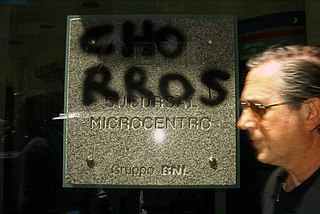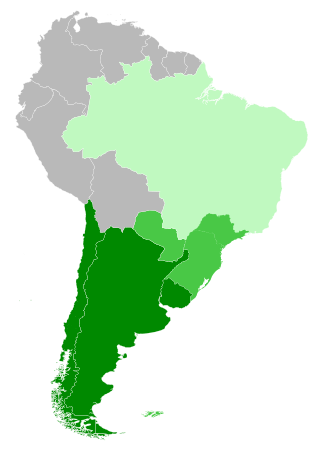
Latin America is a collective region of the Americas where Romance languages—languages derived from Latin—are predominantly spoken. The term was coined in France in the mid-19th century to refer to regions in the Americas that were ruled by the Spanish, Portuguese, and French empires.

Uruguay, officially the Oriental Republic of Uruguay, is a country in South America. It shares borders with Argentina to its west and southwest and Brazil to its north and northeast, while bordering the Río de la Plata to the south and the Atlantic ocean to the southeast. It is part of the Southern Cone region of South America. Uruguay covers an area of approximately 181,034 square kilometres (69,898 sq mi) and has a population of around 3.4 million, of whom nearly 2 million live in the metropolitan area of its capital and largest city, Montevideo.
The history of Uruguay comprises different periods: the pre-Columbian time or early history, the Colonial Period (1516–1811), the Period of Nation-Building (1811–1830), and the history of Uruguay as an independent country (1830-present).

Salsa criolla is a type of sauce or relish found in Latin American cuisine, composed of finely chopped sliced onions, vinegar, tomatoes, garlic, chili peppers, bell peppers, olive oil, salt, pepper and fresh herbs like parsley or cilantro. Salsa criolla is often associated with Peruvian cuisine, but also found in Cuban, Puerto Rican, Nicaraguan, Uruguayan, and Argentinian cuisine.

Lunfardo is an argot originated and developed in the late 19th and early 20th centuries in the lower classes in Buenos Aires and from there spread to other urban areas nearby, such as the Greater Buenos Aires, Rosario and Montevideo.

The Southern Cone is a geographical and cultural subregion composed of the southernmost areas of South America, mostly south of the Tropic of Capricorn. Traditionally, it covers Argentina, Chile, and Uruguay, bounded on the west by the Pacific Ocean and on the east by the Atlantic Ocean. In terms of social, economic and political geography, the Southern Cone comprises Argentina, Chile, and Uruguay, and sometimes includes Brazil's four southernmost states. In its broadest definition, taking into account common history and geography, it also includes Paraguay, another Spanish-speaking country.

The region known as Hispanic America and historically as Spanish America is all the Spanish-speaking countries of the Americas. In all of these countries, Spanish is the main language - sometimes sharing official status with one or more indigenous languages or English, and Roman Catholicism is the predominant religion.

Creole cuisine is a cuisine style born in colonial times, from the fusion between European, African and pre-Columbian American traditions. Creole is a term that refers to those of European origin who were born in the New World and have adapted to it.

The United Provinces of the Río de la Plata, earlier known as the United Provinces of South America, was a name adopted in 1816 by the Congress of Tucumán for the region of South America that declared independence in 1816, with the Sovereign Congress taking place in 1813, during the Argentine War of Independence (1810–1818) that began with the May Revolution in 1810. It originally comprised rebellious territories of the former Spanish Viceroyalty of the Río de la Plata dependencies and had Buenos Aires as its capital.

A facón is a fighting and utility knife widely used in Argentina, Brazil, and Uruguay as the principal tool and weapon of the gaucho of the South American pampas. Often fitted with an elaborately decorated metal hilt and sheath, the facón has a large, heavy blade measuring from 25 cm to 51 cm in length.

Luis Conrado Batlle y Berres was a Uruguayan political figure.

Ariel Ramírez was an Argentine composer, pianist and music director. He was considered "a chief exponent of Argentine folk music" and noted for his "iconic" musical compositions.

The Pontifical Catholic University of Argentina, also known as Catholic University of Argentina (Spanish: Universidad Católica Argentina, is a private university in Argentina with campuses in the cities of Buenos Aires, Santa Fe, Rosario, Paraná, Mendoza and Pergamino. The main campus is located in Puerto Madero, a modern neighborhood of Buenos Aires.

The Central American Integration System has been the economic and political organization of Central American states since 1 February 1993. On 13 December 1991, the ODECA countries signed the Protocol of Tegucigalpa, extending earlier cooperation for regional peace, political freedom, democracy and economic development. SICA's General Secretariat is in El Salvador.

The Southern Common Market, commonly known by Spanish abbreviation Mercosur, and Portuguese Mercosul, is a South American trade bloc established by the Treaty of Asunción in 1991 and Protocol of Ouro Preto in 1994. Its full members are Argentina, Brazil, Paraguay and Uruguay. Venezuela is a full member but has been suspended since 1 December 2016. Associate countries are Bolivia, Chile, Colombia, Ecuador, Guyana, Peru, and Suriname.
Jeitinho is a Portuguese word to describe a method of finding a way to accomplish something by circumventing or bending the rules or transgressing social conventions. The concept is a deeply ingrained part of Brazilian culture.

Argentine Uruguayans are people born in Argentina who live in Uruguay. In 2010, there were over 10,000 Argentines living in Uruguayan territory.

Ricardo Mollo is an Argentine musician, producer, singer and composer of Argentinian rock.

The Massacre of Salsipuedes, commonly known in Spanish as the Slaughterof Salsipuedes was a genocidal attack carried out on 11 April 1831 by the Uruguayan Army, under the command of President Fructuoso Rivera, as the culmination of the government's efforts to eradicate the Charrúa from Uruguay. The massacre took place on the riverbanks of the Great Salsipuedes Creek, named after the massacre in question. The name is a contraction of the Spanish phrase sal si puedes ; it is commonly, but erroneously, thought of as the event that led to the complete extinction of the Charrúa.
White Paraguayans or European Paraguayans are Paraguayan people whose ancestry lies within the continent of Europe, most notably Spain, Italy and Germany, and to a lesser extent, Ukraine and Poland.

















